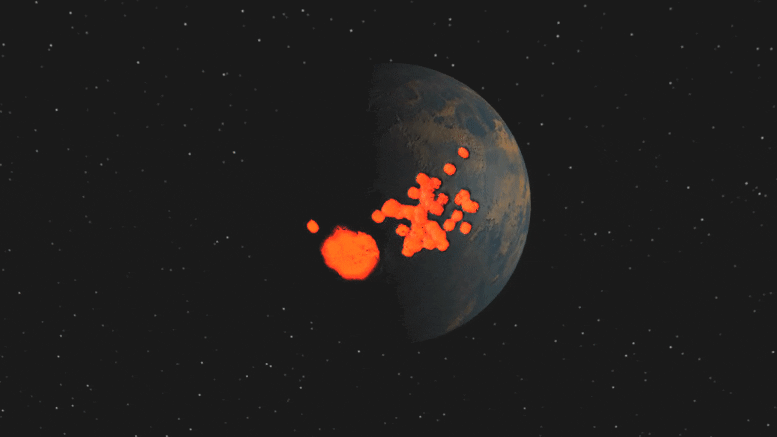
This artistic conception illustrates large asteroids penetrating Earth’s oxygen-poor atmosphere.
Between 2.5 and 4 billion years ago, a time known as the Archean eon, Earth’s weather could often be described as cloudy with a chance of asteroid.While this has all been generally accepted by the geologists, what hasn’t been as well understood is how often these large asteroids would hit and how exactly the fallout from the impacts affected the atmosphere, specifically oxygen levels.
In a new study, Nadja Drabon, a Harvard assistant professor of Earth and planetary sciences, was part of a team that analyzed remnants of ancient asteroids and modeled the effects of their collisions to show that the strikes took place more often than previously thought and may have delayed when oxygen started accumulating on the planet.“Free oxygen in the atmosphere is critical for any living being that uses respiration to produce energy,” Drabon said.“Without the accumulation of oxygen in the atmosphere we would probably not exist.”.
A Southwest Research Institute-led team updated planetary bombardment models to understand how large impacts, such as the one illustrated here, may have affected oxygen levels in the Earth’s atmosphere in the Archean eon, 2.5 to 4 billion years ago.
The researchers found existing planetary bombardment models underestimate how frequent asteroids and comets would hit Earth.The new, higher collision rate suggest impactors hit the planet roughly every 15 million years, about 10 times higher than current models.
They are actually ancient evidence, known as impact spherules, that formed in the fiery collisions each time large asteroids or comets struck the planet.
An SwRI-led study updated bombardment models based on small glassy particles, known as impact spherules, that populate multiple thin, discrete layers in the Earth’s crust, ranging in age from about 2.4 to 3.5 billion years old.This allowed the Southwest Research Institute team to update their bombardment models to find the collision rate had been underestimated.
They essentially found that the accumulated effects of meteorite impacts by objects larger than six miles probably created an oxygen sink that sucked most of the oxygen out of the atmosphere.
The findings align with the geological record, which shows that oxygen levels in the atmosphere varied but stayed relatively low in the early Archean eon.This was the case until around 2.4 billion years ago, during the tail end of this time period when the bombardment slowed down.
The Earth then went through a major shift in surface chemistry triggered by the rise of oxygen levels known as the Great Oxidation Event.
October 20, 2021